Numerous electronic warfare variants based on the Mi-8T and Mi-8MT airframes were developed. They can be divided into three main categories: intelligence, electronic countermeasures (ECM) and airborne command posts. All these models were observed within the GSFG, most of them clearly identified, while others were poorly documented and some even totally unknown, probably never spotted elsewhere.
The Disrupters
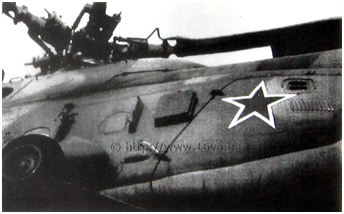
 The task of the electronic countermeasures helicopters was the protection of aircraft and helicopter formations on the front line by jamming acquisition
and tracking radars (GCI) and antiaircraft defenses and command, control and communication centers (C³). Russian author Sergey Burdin gives us the following
figures (we assume that they are valid for a helicopter like the Mi-8PPA): the efficiency of a single helicopter protecting a group of aircraft flying at an
altitude between 500 and 1000 meters was near 100% at a range of 20-70 km from the enemy radars. The latter decreased by 50% at a range of 10-20 km. However,
the ECM helicopters usually operated in groups of two or four. This corresponds to the number of helicopters on strength with the separate combat and control
helicopter squadrons based in the GDR. The power of the ECM systems inevitably had adverse effects for its own users. The avionics of the jammer platform were
affected, as was the range of the radio communications with the group of aircraft or helicopter to be protected, this being reduced to a radius of about 5 km.
During exercises in the GDR, CME platforms used unusual communication frequencies.
The task of the electronic countermeasures helicopters was the protection of aircraft and helicopter formations on the front line by jamming acquisition
and tracking radars (GCI) and antiaircraft defenses and command, control and communication centers (C³). Russian author Sergey Burdin gives us the following
figures (we assume that they are valid for a helicopter like the Mi-8PPA): the efficiency of a single helicopter protecting a group of aircraft flying at an
altitude between 500 and 1000 meters was near 100% at a range of 20-70 km from the enemy radars. The latter decreased by 50% at a range of 10-20 km. However,
the ECM helicopters usually operated in groups of two or four. This corresponds to the number of helicopters on strength with the separate combat and control
helicopter squadrons based in the GDR. The power of the ECM systems inevitably had adverse effects for its own users. The avionics of the jammer platform were
affected, as was the range of the radio communications with the group of aircraft or helicopter to be protected, this being reduced to a radius of about 5 km.
During exercises in the GDR, CME platforms used unusual communication frequencies.
The first Soviet helicopters modified to carry out electronic countermeasures missions appeared in the early 1960s. They were Mi-4MK "Hound" carrying a "Mayak-3"
(Beacon) jamming system and several were based in the GDR (see > The Mi-4). The introduction of the Mi-8T
into service naturally led to numerous modifications of the latter into specialized versions, including electronic warfare.
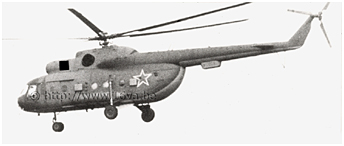
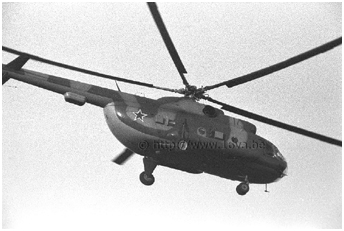 The first electronic countermeasures version seems to have been the Mi-8SMV in 1971. The "Hip-J" as it was designated by NATO
(1) carried a
SPS-88 "Smal'ta-V" suite (hence the SMV suffix) intended to protect frontal aviation by jamming surface-to-air missile guidance systems and, in particular, those
of the MIM-23 "Hawk." They were well known to the Western intelligence community despite their small number. The West German Border Guards indeed reported at regular
intervals their presence along the Iron Curtain. The Mi-8SMV looked at first sight like an ordinary Mi-8T without weapon pylons. However, two rectangular boxes were
mounted symmetrically on each side of the fuselage, behind the third porthole (the second on the right side, given the absence of the front window) and after the last
one. A deflector was mounted behind the front antenna (reception) and in front of the rear antenna (emission). The fourth porthole on the right was obscured by a metal
plate, as sometimes was the case for the last porthole on the left side (here, an articulated hatch was present). They could have been the location for flare launchers.
Continuous emission radars were jammed by sending back their own signals, while pulse emission radars were subjected to direct interference. The countermeasures were
alternately from the left and right sides of the helicopter in seven different directions and on ten frequencies. The system could run for four hours in a row. According
to aeronautical author Piotr Butowski, the modernized Mi-8SMV-PG used in the 2008 conflict with Georgia helped reduce the range of the Buk-M1 and S-125 SAM system guidance
radars by half (from 25-30 km to 10-15 km).
The first electronic countermeasures version seems to have been the Mi-8SMV in 1971. The "Hip-J" as it was designated by NATO
(1) carried a
SPS-88 "Smal'ta-V" suite (hence the SMV suffix) intended to protect frontal aviation by jamming surface-to-air missile guidance systems and, in particular, those
of the MIM-23 "Hawk." They were well known to the Western intelligence community despite their small number. The West German Border Guards indeed reported at regular
intervals their presence along the Iron Curtain. The Mi-8SMV looked at first sight like an ordinary Mi-8T without weapon pylons. However, two rectangular boxes were
mounted symmetrically on each side of the fuselage, behind the third porthole (the second on the right side, given the absence of the front window) and after the last
one. A deflector was mounted behind the front antenna (reception) and in front of the rear antenna (emission). The fourth porthole on the right was obscured by a metal
plate, as sometimes was the case for the last porthole on the left side (here, an articulated hatch was present). They could have been the location for flare launchers.
Continuous emission radars were jammed by sending back their own signals, while pulse emission radars were subjected to direct interference. The countermeasures were
alternately from the left and right sides of the helicopter in seven different directions and on ten frequencies. The system could run for four hours in a row. According
to aeronautical author Piotr Butowski, the modernized Mi-8SMV-PG used in the 2008 conflict with Georgia helped reduce the range of the Buk-M1 and S-125 SAM system guidance
radars by half (from 25-30 km to 10-15 km).
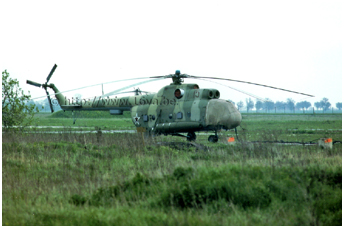
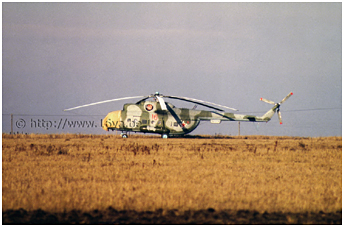 The "Smal'ta" complex (Smalt, a blue pigment) - which required the presence of only one operator aboard the Mi-8SMV - was first successfully tested on the ground
(2) in real conditions in the Beqaa Valley (Lebanon) in 1972. Sergey Burdin said that the complex was placed on a high point
overlooking the entrance to the valley in the demilitarized zone occupied by Syria. An Israeli Hawk battery protected the valley from frequent Syrian aircraft raids. Soviet
operators of the "Smal'ta" system waited for a Hawk to be fired to start the jamming, which then disrupted the missile flight, the latter ending up on the ground or destroyed by
its self-destruction system. In 1982, a few Mi-8SMV and Mi-8PPA were dispatched to Syria as a consequence of the Israeli invasion of Lebanon. They were assigned to the 100th
Separate Electronic Warfare Helicopter Detachment (100.OVO REB) based in Mezzeh, southwest of Damascus (see > Link
(3) / > Photos). According to the link mentioned above, the Syrian detachment -
of which the composition probably varied over time - was repatriated in 1988 and the bulk of the equipment transferred to the 292.OVE REB. We will discuss this unit later since all
the Mi-8SMV present in the GDR were assigned to it. Note however that several helicopters (apparently Mi-8PPB) seem to have been immediately placed in storage when they returned.
Some were indeed photographed in Gorelovo, at ARZ 419 (Aviation Repair Plant 419) (> Link) still bearing their Syrian
markings that do not seem to have been retouched; however, at least one was retouched with Soviet markings.
The "Smal'ta" complex (Smalt, a blue pigment) - which required the presence of only one operator aboard the Mi-8SMV - was first successfully tested on the ground
(2) in real conditions in the Beqaa Valley (Lebanon) in 1972. Sergey Burdin said that the complex was placed on a high point
overlooking the entrance to the valley in the demilitarized zone occupied by Syria. An Israeli Hawk battery protected the valley from frequent Syrian aircraft raids. Soviet
operators of the "Smal'ta" system waited for a Hawk to be fired to start the jamming, which then disrupted the missile flight, the latter ending up on the ground or destroyed by
its self-destruction system. In 1982, a few Mi-8SMV and Mi-8PPA were dispatched to Syria as a consequence of the Israeli invasion of Lebanon. They were assigned to the 100th
Separate Electronic Warfare Helicopter Detachment (100.OVO REB) based in Mezzeh, southwest of Damascus (see > Link
(3) / > Photos). According to the link mentioned above, the Syrian detachment -
of which the composition probably varied over time - was repatriated in 1988 and the bulk of the equipment transferred to the 292.OVE REB. We will discuss this unit later since all
the Mi-8SMV present in the GDR were assigned to it. Note however that several helicopters (apparently Mi-8PPB) seem to have been immediately placed in storage when they returned.
Some were indeed photographed in Gorelovo, at ARZ 419 (Aviation Repair Plant 419) (> Link) still bearing their Syrian
markings that do not seem to have been retouched; however, at least one was retouched with Soviet markings.
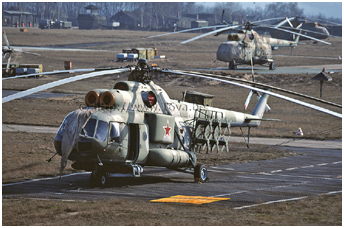
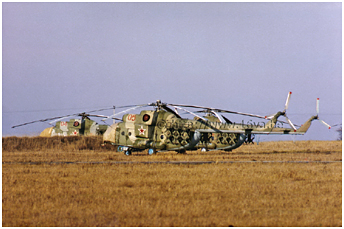 Another ECM version of the Mi-8 was born in 1973-74. It was designated Mi-8PP (Postanovschik Pomekh or jammer). "PP" was actually the compression of a designation that should
also have included the initial of the jamming system called "Pole" (Field). In order for the helicopter to carry this suite, two large rectangular fairings with a large access
hatch were mounted on the fuselage flanks, resulting in the disappearance of the third and fourth portholes. A priori, a series of six heat exchangers necessary for cooling the
electronics was mounted under the fuselage behind the front landing gear leg. A priori, this model was equipped with a "Fasol'" (Bean) jammer like the Mi-8PPA described below.
If that was the case, there should be no external difference between a PP and a PPA model.
It is the next version, designated Mi-8PPA (Postanovschik Pomekh Azaliya) and known in the West as the "Hip-K," that in principle was observed in the GDR.
This helicopter joined the Soviet Armed Forces in the early eighties (an anonymous crew member claims on the Internet to have flown in this version already in 1978). The Mi-8PPA was
carrying an "Azaliya" ECM complex comprising an SPS-63 or SPS-66 jamming system. This equipment weighed 200 kg and was located in the same fuselage side fairings as with the Mi-8PP.
This is the same complex that the Tu-16E Azaliya in Long-Range Aviation carried.
Another ECM version of the Mi-8 was born in 1973-74. It was designated Mi-8PP (Postanovschik Pomekh or jammer). "PP" was actually the compression of a designation that should
also have included the initial of the jamming system called "Pole" (Field). In order for the helicopter to carry this suite, two large rectangular fairings with a large access
hatch were mounted on the fuselage flanks, resulting in the disappearance of the third and fourth portholes. A priori, a series of six heat exchangers necessary for cooling the
electronics was mounted under the fuselage behind the front landing gear leg. A priori, this model was equipped with a "Fasol'" (Bean) jammer like the Mi-8PPA described below.
If that was the case, there should be no external difference between a PP and a PPA model.
It is the next version, designated Mi-8PPA (Postanovschik Pomekh Azaliya) and known in the West as the "Hip-K," that in principle was observed in the GDR.
This helicopter joined the Soviet Armed Forces in the early eighties (an anonymous crew member claims on the Internet to have flown in this version already in 1978). The Mi-8PPA was
carrying an "Azaliya" ECM complex comprising an SPS-63 or SPS-66 jamming system. This equipment weighed 200 kg and was located in the same fuselage side fairings as with the Mi-8PP.
This is the same complex that the Tu-16E Azaliya in Long-Range Aviation carried.

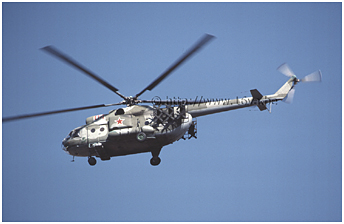 The external appendages of the SPS-5M2 "Fasol'" jamming system aboard the "Hip-K" emphasized its personality: besides the large lateral fairings and six heat exchangers under the nose,
the presence of the Fasol' system dipole cruciform antennas gave the Mi-8PPA its unparalleled appearance of a helicopter equipped with "fans"! Mounting this set of antennas took
the place of the last porthole. Also, the signal cartridge launcher usually mounted on the side of the left clamshell door was moved above the fifth porthole to the left. The Fasol'
complex also was mounted aboard various aircraft such as the Tu-16E, Tu-22P, Yak-28PP or Su-24MP. Note that the DIV-1 Doppler case was not mounted under the tail boom of the "Hip-K"
based in the GDR.
The external appendages of the SPS-5M2 "Fasol'" jamming system aboard the "Hip-K" emphasized its personality: besides the large lateral fairings and six heat exchangers under the nose,
the presence of the Fasol' system dipole cruciform antennas gave the Mi-8PPA its unparalleled appearance of a helicopter equipped with "fans"! Mounting this set of antennas took
the place of the last porthole. Also, the signal cartridge launcher usually mounted on the side of the left clamshell door was moved above the fifth porthole to the left. The Fasol'
complex also was mounted aboard various aircraft such as the Tu-16E, Tu-22P, Yak-28PP or Su-24MP. Note that the DIV-1 Doppler case was not mounted under the tail boom of the "Hip-K"
based in the GDR.
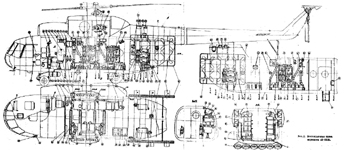
 The Mi-8PPA had greater range thanks to the large fuel tanks carrying 1140 and 1030 liters (see > the first part
of this chapter). A footboard was added under the side access door probably to prevent the crew from stepping on the heat exchanger located under the door when they boarded!
Only one operator was responsible for the electronic warfare suite, bringing the total crew to four men. He was seated to the right behind the cockpit bulkhead and a second
bulkhead with a central door separated him from the electronics compartment (photos showing the interior of a Mi-8PPA > 1 /
2). The Mi-8PPA were normally equipped with a deflector located above the rear part of the fuselage side fairings.
It was intended to protect the equipment from the hot exhaust gas (> Photo of a Mi -8PPA with baffles -
also present on the Mi-8MTPI photo bottom right. However, the helicopters observed during the 1980s and at present rarely were equipped with them and this criterion is probably not valid
when trying to distinguish between a PP model and a PPA version. The "Azaliya" ECM system was designed for jamming ground acquisition radars in the centimeter and decimeter frequency
bands using a transmitter with a power output ranging from 150 to 250 watts. The transmitter radiation was 360° in azimuth and 180° in elevation. The complex could be used continuously
for up to ten hours.
The Mi-8PPA had greater range thanks to the large fuel tanks carrying 1140 and 1030 liters (see > the first part
of this chapter). A footboard was added under the side access door probably to prevent the crew from stepping on the heat exchanger located under the door when they boarded!
Only one operator was responsible for the electronic warfare suite, bringing the total crew to four men. He was seated to the right behind the cockpit bulkhead and a second
bulkhead with a central door separated him from the electronics compartment (photos showing the interior of a Mi-8PPA > 1 /
2). The Mi-8PPA were normally equipped with a deflector located above the rear part of the fuselage side fairings.
It was intended to protect the equipment from the hot exhaust gas (> Photo of a Mi -8PPA with baffles -
also present on the Mi-8MTPI photo bottom right. However, the helicopters observed during the 1980s and at present rarely were equipped with them and this criterion is probably not valid
when trying to distinguish between a PP model and a PPA version. The "Azaliya" ECM system was designed for jamming ground acquisition radars in the centimeter and decimeter frequency
bands using a transmitter with a power output ranging from 150 to 250 watts. The transmitter radiation was 360° in azimuth and 180° in elevation. The complex could be used continuously
for up to ten hours.
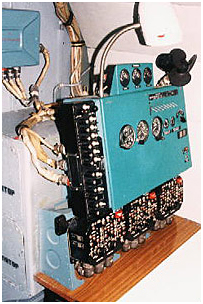 Console de l'opérateur des systèmes ECM d'un Mi-8PPA. © DR
Console de l'opérateur des systèmes ECM d'un Mi-8PPA. © DR
ECM operator console of a Mi-8PPA. © DR
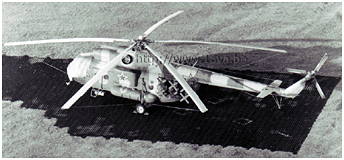 Since no receiver was used to identify the threats, the system scanned the entire available frequency range in steps of 240 MHz. The jamming duration of each step varied anarchically.
The "Fasol'" dealt with acquisition and guidance radars operating in the meter frequency bands. It was a 20-watt selective transmitter that jammed the identified enemy frequencies.
The selected frequency range was scanned in steps of 20 MHz. During the 2008 conflict with Georgia, the Mi-8PPA would have reduced the effective range of the Georgian search radars from
300 to 30-50 km. The first Mi-8PPA observed in the GDR by Western intelligence sources were helicopters from the 292nd Separate Electronic Warfare Helicopter Squadron -(literally of
radio-electronic combat - (OVE REB for Otdel'naya Vertoletnaya Eskadril'ya Radioelektronnoy Borb'y), based at Allstedt since 1981. This particular squadron was subordinated
directly to the VVS rather than Army Aviation, so it took its orders from 16.VA Headquarters. In May 1985, the unit moved to Cochstedt where it remained stationed until its withdrawal
from Germany in July 1992. In addition, a few Mi-8PPA were on strength with three of the five separate combat and control helicopter squadrons (OVE BU) assigned to the five ground armies
(4).
Since no receiver was used to identify the threats, the system scanned the entire available frequency range in steps of 240 MHz. The jamming duration of each step varied anarchically.
The "Fasol'" dealt with acquisition and guidance radars operating in the meter frequency bands. It was a 20-watt selective transmitter that jammed the identified enemy frequencies.
The selected frequency range was scanned in steps of 20 MHz. During the 2008 conflict with Georgia, the Mi-8PPA would have reduced the effective range of the Georgian search radars from
300 to 30-50 km. The first Mi-8PPA observed in the GDR by Western intelligence sources were helicopters from the 292nd Separate Electronic Warfare Helicopter Squadron -(literally of
radio-electronic combat - (OVE REB for Otdel'naya Vertoletnaya Eskadril'ya Radioelektronnoy Borb'y), based at Allstedt since 1981. This particular squadron was subordinated
directly to the VVS rather than Army Aviation, so it took its orders from 16.VA Headquarters. In May 1985, the unit moved to Cochstedt where it remained stationed until its withdrawal
from Germany in July 1992. In addition, a few Mi-8PPA were on strength with three of the five separate combat and control helicopter squadrons (OVE BU) assigned to the five ground armies
(4).
An Mi-8SMV and Mi-8PPA were used as ESM (Electronic Support Measures) platforms during air operations and air assault exercises. A "Hip-J" acting as a formation leader communicated the
on/off switch commands to a "Hip-K" according to an exact time table.
The distance between the helicopters and the area of operations ranged from 50 to 70 km and the altitude did not exceed 3000 meters.
During support missions to cover the aircraft takeoff and landing phases, the maximum distance was 30 km at an altitude varying between 900 and 1200 meters.
Sometimes the Mi-8PPA flew alone.
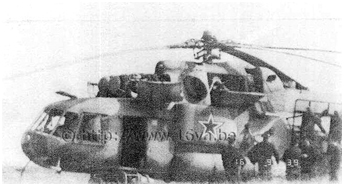
 The Mi-8PPA and the Mi-8SMV (respectively seven and eight helicopter + one Mi-8T) of the 292.OVE REB were listed by European aircraft spotters at Cochstedt after the fall of the Berlin Wall.
Thus, the recent composition of the squadron seemed well known, but it was not reflected in the 1985 USMLM annual history.
In that 1985 history, we could indeed see this photo on the left that apparently shows a Mi-8PPA. But the description stated that it was a "Hip-H" airframe - hence a Mi-8MT -
while, as we have seen, the "Hip-K" was based on a Mi-8T airframe. Plus, a closer look at the image makes it possible to partially distinguish a boomerang-shaped antenna in front
of the "Fasol'" system antenna. We also managed to find a another picture of a similar helicopter at Cochstedt (above, right). Besides the boomerang antenna, we also can distinguish a
triangular fairing behind it, instead of the fifth porthole. These helicopters that seem to have been assigned to the 292.OVE REB were Mi-8MTPI - P for Postanovschik Pomekh
and I for Ikebana (school of Japanese floral art) - sometimes called Mi-8PPI at unit level.
The Mi-8PPA and the Mi-8SMV (respectively seven and eight helicopter + one Mi-8T) of the 292.OVE REB were listed by European aircraft spotters at Cochstedt after the fall of the Berlin Wall.
Thus, the recent composition of the squadron seemed well known, but it was not reflected in the 1985 USMLM annual history.
In that 1985 history, we could indeed see this photo on the left that apparently shows a Mi-8PPA. But the description stated that it was a "Hip-H" airframe - hence a Mi-8MT -
while, as we have seen, the "Hip-K" was based on a Mi-8T airframe. Plus, a closer look at the image makes it possible to partially distinguish a boomerang-shaped antenna in front
of the "Fasol'" system antenna. We also managed to find a another picture of a similar helicopter at Cochstedt (above, right). Besides the boomerang antenna, we also can distinguish a
triangular fairing behind it, instead of the fifth porthole. These helicopters that seem to have been assigned to the 292.OVE REB were Mi-8MTPI - P for Postanovschik Pomekh
and I for Ikebana (school of Japanese floral art) - sometimes called Mi-8PPI at unit level.
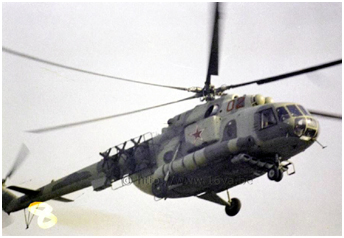
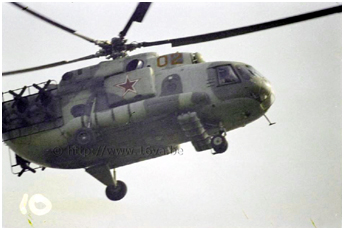 This variant was very similar externally to the Mi-8PPA with large fuselage side
fairings, "Fasol'" system antennas and heat exchangers. But, besides the external characteristics of the Mi-8MT airframe (see > the
third part of this chapter), the boomerang antennas of the "Ikebana" complex mounted in front of those of the "Fasol'" jammer betrayed it for sure. The "Ikebana" suite was not only
an electronic countermeasures system; it also could be used for ELINT missions. The Mi-8MTPI, therefore, was a multimission helicopter likely requiring an additional operator.
This version was equipped with large fuel tanks like the Mi-8PPA.
The Mi-8MTPIs seem to have remained in the GDR at least until 1990, since the BRIXMIS annual report was illustrated with the picture of Mi-8PPA n°02 taken in March, with the caption
"HIP H EW 1 WITHOUT BAT WING OR RED PAN ANTENNAE." It is clear that "Bat Wing" referred to the antennae also resembling a boomerang of the Ikebana complex and "Red Pan" referred to
the triangular fairing.
This variant was very similar externally to the Mi-8PPA with large fuselage side
fairings, "Fasol'" system antennas and heat exchangers. But, besides the external characteristics of the Mi-8MT airframe (see > the
third part of this chapter), the boomerang antennas of the "Ikebana" complex mounted in front of those of the "Fasol'" jammer betrayed it for sure. The "Ikebana" suite was not only
an electronic countermeasures system; it also could be used for ELINT missions. The Mi-8MTPI, therefore, was a multimission helicopter likely requiring an additional operator.
This version was equipped with large fuel tanks like the Mi-8PPA.
The Mi-8MTPIs seem to have remained in the GDR at least until 1990, since the BRIXMIS annual report was illustrated with the picture of Mi-8PPA n°02 taken in March, with the caption
"HIP H EW 1 WITHOUT BAT WING OR RED PAN ANTENNAE." It is clear that "Bat Wing" referred to the antennae also resembling a boomerang of the Ikebana complex and "Red Pan" referred to
the triangular fairing.
While some of the Mi-8 described above were withdrawn from service and dismantled, others were overhauled and still are active alongside many more-recent variants. As a result,
the Mi-8SMV became the Mi-8SMV-PG after mounting a new SPS-88PG ECM suite named "Smal'ta-PG."
notes
(1)
NATO actually identified two different Mi-8SMV versions: "Hip-J1" and "Hip-J2."
The "Hip-J1" was the version illustrated in this article.
It had rectangular deflectors in front or behind the square antenna fairings. The "Hip-J2" had semi-spherical deflectors installed.
However, no known
pictures of that version in service with the GSFG exist.
At most, we can speculate that the central photo visible on this > page maybe shows a "Hip-J2."
(2)
Read the footnote in the fifth part of the article "Seen from the West: the Hawk Batteries"
and the text related to it.
(3)
The pictures illustrating this link (taken in Gorelovo) seem to show a Mi-8PPB equipped with a "Bizon" suite.
Picture of a complete model > Here.
(4)
That was the case in early 1991. They were the following units:
- 6.OVE BU, Hellerau, 1.GvTA, 2 helicopters
- 9.OVE BU, Neuruppin, 2.GvTA, 4 helicopters
- 296.OVE BU, Mahlwinkel, 3.OA, 2 helicopters<
 |
The Mi-8 < Part 1 | < Part 2 | < Part 3 | > Part 5 | > Part 6 | > Part 7 |
 |
Plan du site - Sitemap |  |
